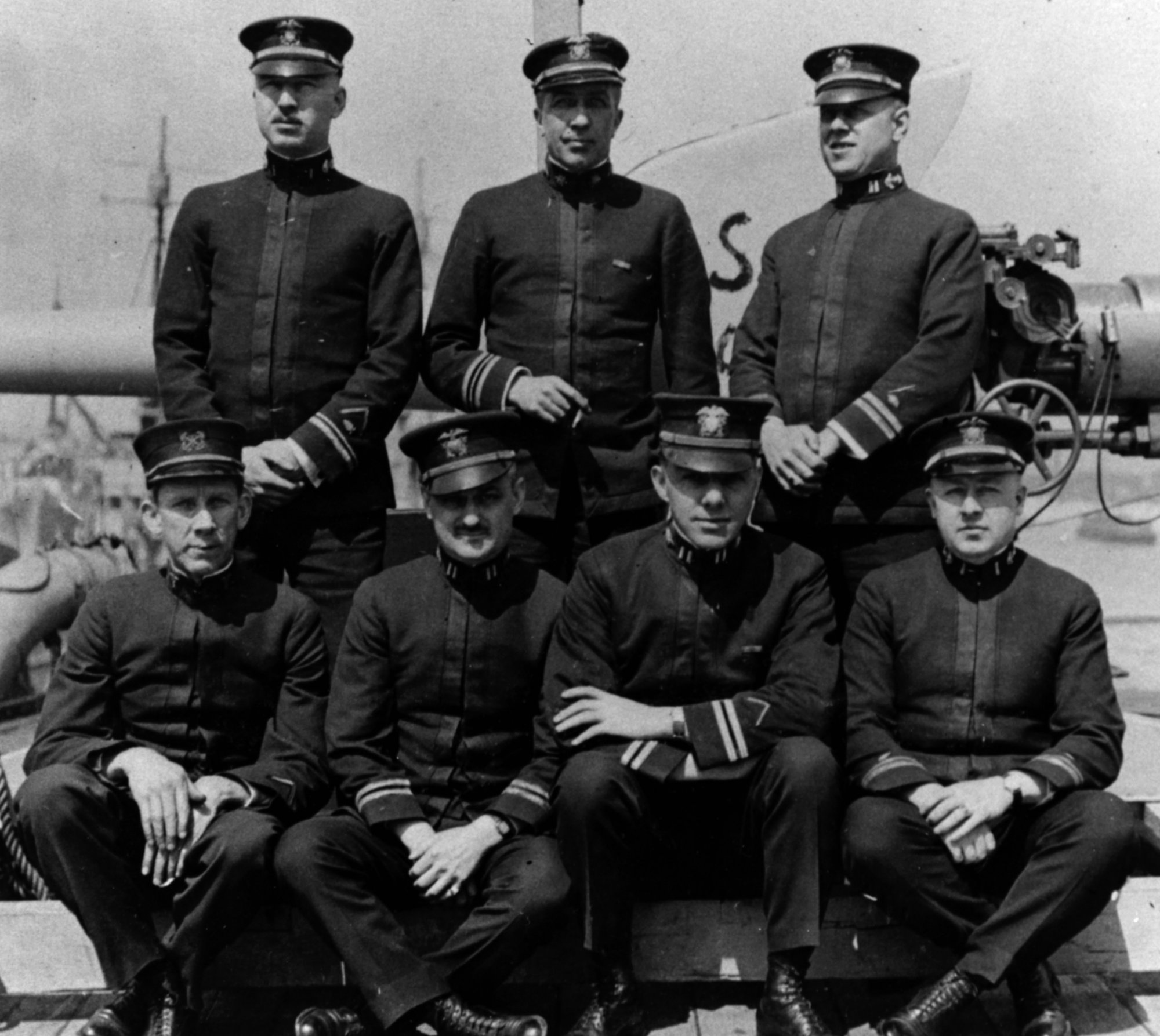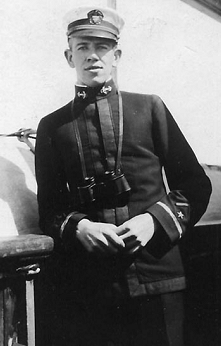
Uniforms & Insignia | Ranks & Organization | Misc. | Contact
In an effort to recognize those who were serving in active combat zones or had been wounded in action, the Allied Forces in the First World War instituted systems of war service and wound badges. The British Army authorized vertical gold wound stripes in August 1916.1 In January 1918, the US Army authorized gold chevrons on the lower sleeve: On the left arm, a gold chevron represented six months deployed in the war zone, on the right arm it represented a wound as a result of enemy action.2 The British Army authorized chevrons for one year's war service in January 1918 as well.1 The U.S. Navy followed with its own service and wound chevrons in September 1918, authorized by Navy Department General Order Number 422, reproduced below.
The Navy's service chevron, worn on the lower left arm, was authorized for a minimum of three months of service in designated combat areas. The first chevron covered up to one year's designated service: a second chevron could be awarded for another three month's service, but only after twelve months had elapsed since the service for the first chevron began. If a vessel had been under direct enemy fire or torpedoed, the three months requirement could be waived. The wound chevron, similar but worn on the right sleeve, was for wounds received as a result of enemy action that required attention by a medical officer.
Evidently there was some confusion about eligibility for the service chevrons, and in October 1918 Rear Admiral Leigh C. Palmer, Chief of the Navy's Bureau of Navigation, issued a circular letter (see below) that attempted to clarify the requirements. Though the orders specify a 60-degree angle for the chevron, in practice it seems that wider angles were common.
When the Victory Medal began to be issued in 1920 with its clasps and stars to represent wartime service, the wartime chevrons were no longer deemed necessary and were not authorized by the Navy Uniform Regulations of 1922.3

|

|

|

|
| Service chevron, commissioned officer |
Service chevron, chief petty officer |
Service chevron, petty officer or non-rated |
Wound chevron, petty officer or non-rated |
 |
 |
| Medical officers aboard USS Kroonland with service chevrons, March 1919. From the Naval History and Heritage Command. | Chief petty officer and lieutenant with service chevrons aboard USS Pocahontas. From the Naval History and Heritage Command. |
 |
| Ensign with service chevron aboard USS Patricia, 1919. From the Naval History and Heritage Command. |
The following orders have been transcribed for readibility and searchability. The original format has been maintained as much as possible.
|
GENERAL ORDER No. 422 NAVY DEPARTMENT WAR SERVICE AND WOUND CHEVRONS 1. War service chevrons and wound chevrons are hereby authorized and may be worn by those entitled to do so.
JOSEPHUS DANIELS,
|
|
October 21, 1918 BUREAU OF NAVIGATION CIRCULAR LETTER No. 198-18 To: All Ships and Stations. Subject: War Service and Wound Chevrons. Reference: General Order No. 422 of September 25, 1918. 1. Numerous inquiries received by the Bureau regarding the interpretation of the above mentioned General Order show that there exists in the service at large considerable misunderstanding as to its intent and application. 2. The intent of the order is to provide a distinguishing mark to each person in the Naval Service who has, by reason of his duty in the Navy, run the risk of direct encounter with the enemy in which his life might be hazarded. The order has been drawn up with the idea of covering every form of service in which any such risk would be met. The wound chevron is similarly intended to provide a distinguishing mark for those who have actually received wounds in action with the enemy. 3. By its language the order makes the wearing of the chevrons optional. No one is required to wear them but they should not be worn by any one not clearly entitled to the privilege. 4. The arms of the chevron are to be placed at an angle of 60 degrees with each other, so that the inner edges of the arms form two sides of an equilateral triangle two inches to the side. The chevron should be so placed upon the sleeves of the line officer's uniform that the open face of the chevron is parallel to the stripes on the sleeve and tangent to the upper two rays of the star, the apex being directly above the star. The chevron is to be placed in a corresponding position on the sleeves of staff officers' and enlisted men's uniform, except that it is not to be super-imposed upon the service stripes worn by enlisted men, but should be placed above them where the space permits. Additional chevrons should be placed ¼-inch above the chevrons already authorized. 5. The sub-paragraphs of paragraph (3) of the order describe the various forms of service which will render the individual eligible for the war service chevron. Eligibility under more than one form of service does not entitle the individual to more than one chevron. The chevron is for WAR SERVICE, and if the individual renders service under several different forms the fact is sufficiently indicated by a single chevron. For example an aviator under paragraph (d) might be entitled to a chevron while attached to an air station on shore and subsequently become entitled to one for foreign service on an aviation ship that would meet conditions of sub-paragraph (b). Such an individual is not entitled to two chevrons. 6. Additional chevrons may be worn only for continued service. Eligibility for the second chevron does not begin to accrue until twelve months of actual, eligible service have elapsed from the beginning of the service entitling the wearer to his first chevron. Eligibility for the third chevron does not begin to accrue until the lapse of twenty-four months of actual eligible service from the beginning of the service entitling the wearer to the first chevron. 7. If risk of life in action has been actually realized on a ship torpedoed or fired upon by enemy vessels, the requirement of three months is deemed unnecessary, but in any such case there must be positive proof of such attack. Engagement with a phantom submarine does not entitle the individual to a chevron. 8. Where the risk can reasonably be described as intermittent, which is true even of service in the war zone, it is deemed advisable to require three months of service before eligibility can be established. Where detachment from such intermittent duty, as for example that performed by transports, has occurred prior to the completion of three full months from the date that the risk is deemed to have begun, the individual is not entitled to the chevron. Even though during the lapse of the deficient period the vessel was not exposed to the enemy attack, the individual by reason of his detachment ceases to be engaged on duty in which the risk is involved. 9. Vessels in convoy when an accompanying vessel has been attacked are not considered as being themselves attacked. Vessels at which torpedoes are believed to have been fired, but which missed, are not considered as being torpedoed. If the individual on such a ship has served more than three months on such duty, he is entitled to the chevron without an actual attack. If he has served less than three months he must clearly and unmistakably be the subject of a real attack. 10. Service in the South Atlantic during the early period of the war, when it was believed that there were German raiders in those waters, may be considered as conferring eligibility. The only known raider that was operating in those waters was subsequently wrecked in the South Pacific and consequently such service after August 31st, 1917, should not be considered as conferring eligibility unless other conditions of risk arise, to be determined by the Department when the occasion arises. The 37th meridian west of Greenwich is the western boundary of the danger area proclaimed by Germany at the beginning of her unrestricted submarine warfare. Consequently service east of that meridian from the beginning of the war is to be construed as conferring eligibility. Without any preceding proclamation the Germans extended the war area to the Atlantic Coast of the United States in sending submarines to this side. The first positive knowledge of the operations of such submarines was of the date of May 25, 1918. From and after that date the risk may be considered as extending entirely across the Atlantic, but in the absence of any definite information warranting such conclusions, such a risk is deemed not to exist south of the equator. Since enemy submarines did not actually enter our harbors, and are not likely to do so, service on coast patrol vessels does not count, unless such vessels actually cruised the high seas, outside of the defensive sea areas of our harbors, in search of enemy vessels, in which there existed liability of being attacked by such enemy vessel. Service of not less than three months on such vessels, during which period not less than six actual searching cruises at sea have been made, is necessary to establish eligibility. 11. Paragraph (3), sub-paragraph (a) is to be construed as follows: Only those officers and enlisted men are eligible who have been regularly assigned and detailed to duty and considered available for duty that actually involved flights in aircraft in search of enemy vessels since May 25, 1918, and who have actually made at least six such flights totaling 30 hours while so assigned and detailed. 12. The chevron is a distinguishing mark of service in the Navy. No individual is entitled to wear it except in accordance with this order as it may from time to time be construed. War service in another arm of the service does not entitle the wearer to the Navy war service chevron, nor shall any person in the Naval service wear any war service distinguishing mark granted him in another arm of the service. L. C. Palmer |
Notes:
All text and images © Justin T. Broderick, 2013 unless otherwise indicated.